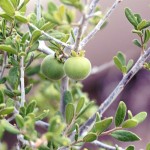Texas persimmon
Diospyros texana Scheele
Ebenaceae (Persimmon family)
Description
Texas persimmon, also called Mexican or black persimmon, is a shrub or small tree that normally grows to less than 15 feet tall. However, some specimens along the upper Texas coast may reach 50 feet tall. Its compact wood is almost black, and the bark is gray, slick and thin.
Texas persimmon has oval leaves that are rounded at the tips. The leaves have small, fine hairs underneath. The fruit contains three to eight seeds and can measure up to 1 inch in diameter. It is green at first, turning black when ripe.
The forage value of Texas persimmon is fair for goats and wildlife.
Habitat
Texas persimmon is found primarily in the western two-thirds of the state in rocky, open woodlands, arroyos, and on open slopes. In some pastures in Central Texas, it may be one of the predominant invading woody species.
Toxic Agent
The toxic agent in persimmon is unknown, and the information in this section is based on observation rather than experimental studies. During periods of drought, there have been years when the persimmon crop was heavy and grass was sparse. Cattle consuming large amounts of ripe or ripening fruit have had problems.
Signs of Livestock Ingestion
Persimmon poisoning does not cause death, but it does result in poor performance. The clinical signs are: Black diarrhea; Colic; Weight loss.
At times, the level of intake is so great that persimmon seeds are about the only solid material in the feces.
Management Strategies
Cattle regain their weight when given adequate nutrition after the fruit is gone. As this usually occurs in drought, expensive supplemental feeding can be required. Prevention is best and can be accomplished by moving cattle to pastures with fewer plants when the fruit begins to ripen. Individual plants of Texas persimmon may be controlled with a basal stem treatment mixture containing 25 percent Remedy® and 75 percent diesel fuel oil to thin out heavily infested pastures. Apply the mixture to the bottom 12 inches of the stem down to the soil surface in the spring after the leaves mature but before June 15.
Images
Plant Characteristics
Flower Color: White
Seed Type: Fruit/Berry
Duration: Perennial
Stem Texture: Hairless/Smooth
Growth Habit: Shrub (Woody)
Leaf Shape
 : Simple with Pinnate or Parallel Venation
: Simple with Pinnate or Parallel Venation
Season: Warm
Distribution
 : 02 - Gulf Prairies and Marshes, 03 - Post Oak Savannah, 04 - Blackland Prairies, 05 - Cross Timbers and Prairies, 06 - South Texas Plains, 07 - Edwards Plateau, 08 - Rolling Plains, 09 - High Plains, 10 - Trans-Pecos
: 02 - Gulf Prairies and Marshes, 03 - Post Oak Savannah, 04 - Blackland Prairies, 05 - Cross Timbers and Prairies, 06 - South Texas Plains, 07 - Edwards Plateau, 08 - Rolling Plains, 09 - High Plains, 10 - Trans-Pecos
Distributions
Distribution refers to the ecological region in Texas that a plant has been found. You can also view a clickable map.
Book: Brush and Weeds of Texas Rangelands (B-6208), Toxic Plants of Texas (B-6105)
Collection: Brush and Weeds, Toxics
Livestock Affected: Cattle
Livestock Signs: Abdominal Pain, Colic, Diarrhea, Loss Of Weight









